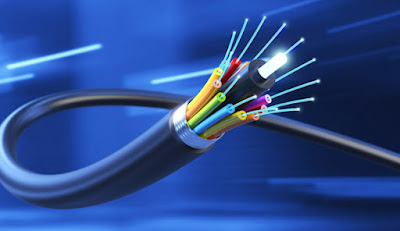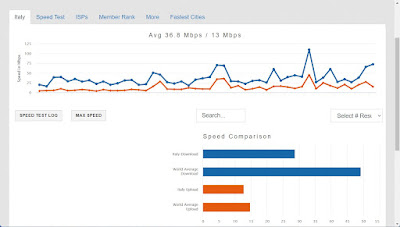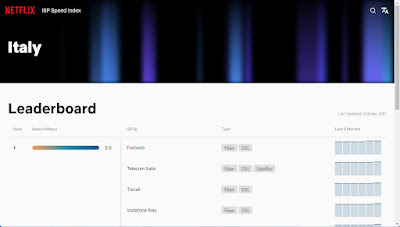Compare the internet connection provided by the ADSL and Fiber connection providers to find the fastest one.

So how to understand, briefly, which operator offers (under the same network conditions) the best line for users? In this guide we will see how compare ADSL and Fiber connection speeds, so as to be able to choose the new operator or a possible passage with the right knowledge of the facts.
READ ALSO: Which mobile operator has the fastest internet in 4G LTE
1) Connection technologies
First, it is worth understanding the difference between connection technologies that you can take advantage of to get the Internet at home; we have talked about them in many guides, but we can briefly summarize them in a compact list:
- ADSL: currently the slowest technology but also the most widespread, with a maximum speed of 20 Mbps (although in many homes it barely gets 5 Mbps). If possible, we must avoid this type of connection, because it is always saturated and subject to sudden drops in performance.
- FTTC (o VDSL): the first interesting technology from the point of view of performance is the FTTC, which brings the optical fiber to the nearest cabinet and distributes the signal with the classic copper cable to homes. This is the right compromise between speed and practicality (since no work inside the house is required), in fact it is spreading visibly in many Italian cities. It offers speeds in excess of 30 Mbps in almost all circumstances, with very interesting peaks in well-covered cities (you also get to 200 Mbps).
- eVDSL: evolution of the traditional FTTC, which brings the connection speed up to 300 Megabits per second while keeping the last part of the connection in copper. This technology could make a real difference in more remote areas but is not properly supported by operators, who tend to offer it in areas where there is already FTTH coverage.
- FTTH: the best connection technology, which brings the optical fiber right into the house. In order to take advantage of it, there must be a compatible cabinet in the area and we will have to make changes to the home socket. The result is amazing: we can navigate at a minimum of 1000 Megabits per second, but in some cities we also travel at 2.5 Gigabits per second (Fastweb and Vodafone) or 10 Gigabits per second (TIM).
- Wireless: some operators, such as EOLO e Linkem, provide Internet connectivity via wireless connection over long distances, that is, dedicated frequencies are used to get the Internet signal to the home as if it were a television signal (so we will need an external antenna to receive the signal).
If we have to sign a new Internet contract at home, let’s make sure that the area is covered by at least FTTC, so as to get a good line whatever the chosen operator (even if, as we will see below, some are better than others).
Obviously the comparisons of the various reports that we are going to analyze take into consideration the average speed of operators with all types of connections: the higher values indicate that that operator has more FTTC and FTTH active on average, but it does not necessarily take well in our home!
To deepen the discussion on the types of connection, I refer you to our article on fiber optic connection technologies.
2) Speed comparison of Italy Speed Test
If we have to compare the average speed of the various operators, the first report to be analyzed is the one offered by the site Italy Speed Test.
The graph immediately shows what the average speed in Italy is in both download and upload: if we get the same or higher values, we can be satisfied.
Bringing us to the tab ISPs we will also be able to evaluate the average speed offered by Internet operators (for home fixed lines): according to the site, the primacy is up to Vodafone, with an average speed of 92 Mbps in download and a speed of 24 Mbps in upload.
This value is well justified by the fact that Vodafone is investing heavily in direct FTTH optical fiber and tries, if possible, to activate new FTTC connections in cities where direct fiber connection is not available: even if it has fewer users, everyone gets on average a much higher speed than the competition, thus bringing the operator to the top of the rankings. This explains, at least in part, the significantly higher prices than rivals.
In second place we find Sky Italia SRL, which has recently become an Internet operator on FTTH: since in fact they only activate direct optical fibers (with very few FTTC activations) we find very high speed values (68 Mbps in download and 38 Mbps in upload). Immediately after Sky we find Fastweb which boasts many connections in FTTC (in addition to FTTH) that bring the average to 67 Mbps in download and 39 Mbps in upload (higher than Sky).
TIM or Telecom Italia (44 Mbps and 18 Mbps) is only in fifth place, surpassed also by Tiscali (43 Mbps and 40 Mbps): this is justified by the fact that many TIM connections are still in ADSL, especially old users or those who live in real places remote. TIM is still the only operator that offers 10 Gigabit per second, but it can only be activated in a very few selected municipalities.
All the other operators follow, who have much lower speeds even for the smallest number of subscribers (despite the often lower prices, they can hardly provide FTTH and FTTC as the top three in the ranking).
3) Netflix speed comparison
Another useful site to compare internet speeds for Providers in Italy is Netflix ISP Speed Index.
This site evaluates the average speed of users connecting to Netflix servers, therefore it presents an even more precise measurement because it is based on the constant download of multimedia content (i.e. streaming movies and TV series).
In the first place of this ranking we find all the most famous Italian operators (Fastweb, Telecom Italia, Tiscali, Vodafone Italy and WindTre), which in fact occupy the leading position with excellent download speeds with all the technologies currently available. In second place we find EOLO, the wireless operator, while in last place we find Linkem.
If we like then see many Netflix content we will have to focus on the operators present in the first place in the standings, so as to be sure of being able to access at least the contents transmitted at standard resolution.
We remind you that to access Netflix FullHD contents an Internet line with at least 10 Megabits per second in download is recommended, while to access the Netflix content in 4K UHD an Internet line of at least 25 Megabits per second is required.
Conclusions
Operators have invested heavily to bring fast Internet to all homes, but as it is easy to guess not everyone can have the same luck, since a lot also changes depending on the street or city in which we live. The advice we can give you is to immediately do a control of Internet technology present at our home or new home (if we have to move), so as to be sure we can activate the best possible technology to surf the Internet.
After discovering the best available technology we carry out a coverage check with all operators, so you can choose the one with the best quality / price ratio.


